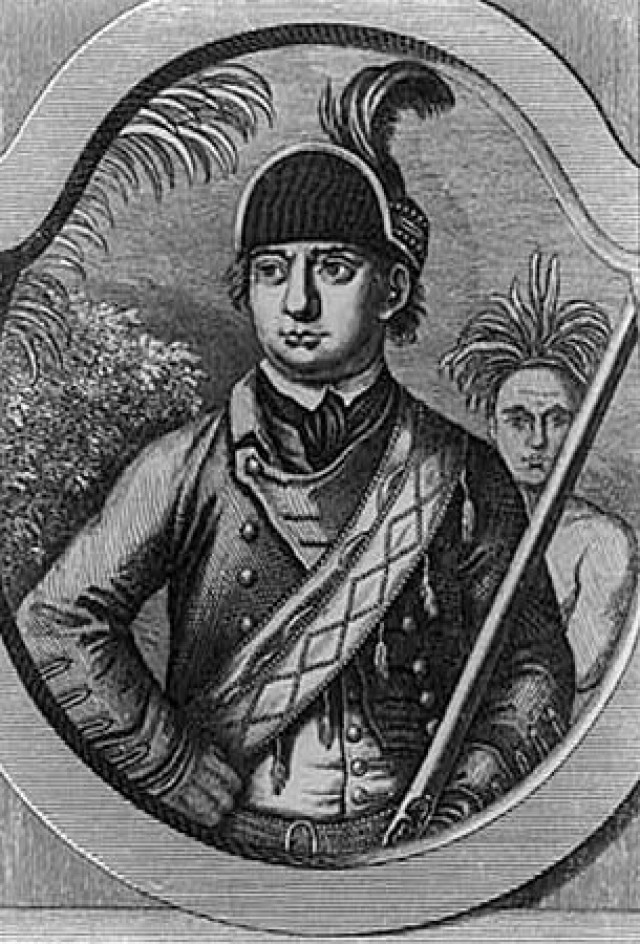When you examine the U.S. ArmyAca,!a,,cs contribution to the development and training of other armies around the world, it is hard to imagine that a portion of the foundations that our Army, and in particular our special forces, are built upon comes from the actions and principles developed by a British officer performing service in North America 250 years ago.
Among 18th Century American military historians and buffs, Maj. Robert Rogers and his Aca,!A"RangersAca,!A? have risen to almost cult-like status, comparable to George Washington or Daniel Boone. Yet, when you look at RogersAca,!a,,c experiences gained while fighting the French and Indians across New York, New England, and Canada, you realize that his war record had far more checks in the Aca,!A"lossAca,!A? column than in the Aca,!A"winAca,!A? column.
It was those losses that prompted Rogers to petition his British commander for permission to create a specialized training base on an Island in the Hudson River (known today as Rogers Island) to train new Rangers. The outpost allowed Rogers to immediately apply what he and his men had learned in the field to their training without the distractions of garrison duty and fort life. Rogers had created a new breed of Soldier for the British Army, not a Soldier who stood in line and fired volley after volley, but one who was trained to operate and think in small unit tactics.
One of the events that helped shape the RangersAca,!a,,c training and showed their ability to adapt and overcome or escape a well-trained, often superior, force was a skirmish that occurred near Fort Carillon (later to be known as Fort Ticonderoga under British occupation) along Lake Champlain in mid-January, 1757.
Rogers and his men had been ordered to reconnoiter the route between Fort William Henry at the southern end of Lake George and Fort Carillon, as intelligence had reached the British that the French were building up supplies and forces at Carillon for an attack southward against the Fort William Henry and Fort Edward in the spring. After resupply at Fort William Henry, RogersAca,!a,,c men, in association with two other ranging companies, moved northward up the western shoreline of Lake George and through the woods to a point on Lake Champlain between Fort Carillon and Fort St. Frederick (Crown Point). On Jan. 21, RogersAca,!a,,c force encountered a lone French sled moving down frozen Lake Champlain toward Fort Carillon.
Rogers sent Lt. John Stark to capture the sled while he headed north with a detachment to prevent its escape. Their intent was to gain intelligence about the French build-up. Unfortunately, they did not see the ten other sleds further up the lake, which observed their maneuver and attempted to retreat back to Fort Carillon for reinforcements. Rogers did manage to capture three of the sleds and learned that a superior force of 90 French regulars and an equal force of Canadian militia and Ottawa Indians also were on their way to St. Frederick.
RogersAca,!a,,c force immediately tried to retreat back down the way they had come, but the French force had cut their tracks in the snow and waited in ambush for them. RogersAca,!a,,c force was met with a strong volley, and several of his men were killed or wounded on the spot. Rogers himself was initially wounded in the head in this first volley. The pitched battle lasted from 2:00 pm until night fall. Lt. StarkAca,!a,,cs men had posted themselves on high ground and used the available cover to fend off repeated French attacks. As darkness fell and the fighting subsided, RogersAca,!a,,c force was able to slip back through the woods and around the pursuing French detachment.
It was noted later by Cpt. Louis-Antoine, comte de Bougainville, aide-de-camp to the Marquis de Montcalm, that RogersAca,!a,,c men had a decided advantage on the retreat due to their use of snow shoes, while the French Regulars were, Aca,!A"floundering in snow up to their knees.Aca,!A?
Rogers reported to Gen. James Abercrombie his losses: 14 dead, 6 missing and 6 wounded, including the loss of one of his unit commanders, Capt. Thomas Speakman. Rogers later relayed to the general that the French had incurred 116 dead and wounded in the conflict. Rogers was able to gain some intelligence on the French commitment to the region through the captives, but the information only delayed the inevitable. In August 1757, Fort William Henry fell to the French, and the famous massacre of the vanquished British command ensued.
It was after this cold January conflict that Rogers created his now famous Aca,!A"Rules of Ranging:Aca,!A? twenty-eight guidelines for how specialized or small units should operate in less than favorable conditions. They have become twenty-eight rules that no Ranger should ever forget. This period playbook has been passed down through the centuries to todayAca,!a,,cs U.S. Army Rangers, with each ranger still being issued an updated version of the Aca,!A"Rules of Ranging.Aca,!A?
ABOUT THIS STORY: Many of the sources presented in this article are among 400,000 books, 1.7 million photos and 12.5 million manuscripts available for study through the U.S. Army Military History Institute (MHI). The artifacts shown are among nearly 50,000 items of the Army Heritage Museum (AHM) collections. MHI and AHM are part of the: Army Heritage and Education Center, 950 Soldiers Drive, Carlisle, PA, 17013-5021.
Related Links:
A Working Bibliography of MHI Sources: Rangers Pre 20th Century


Social Sharing